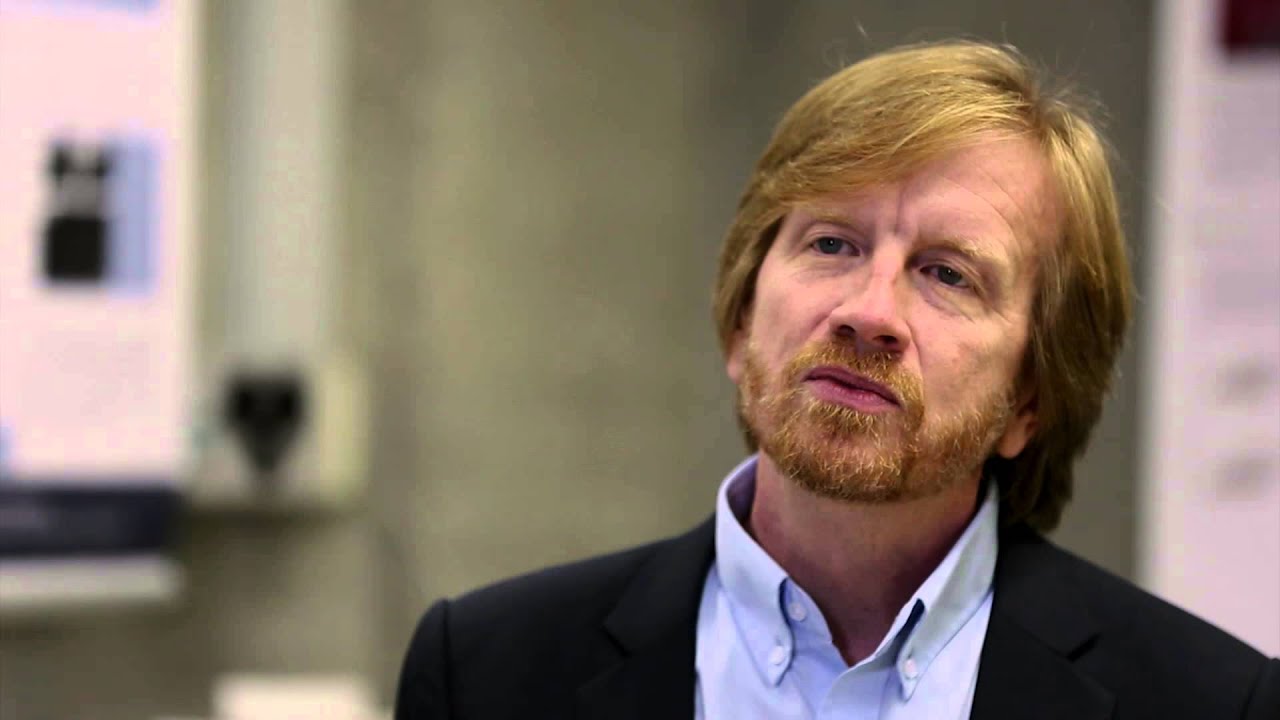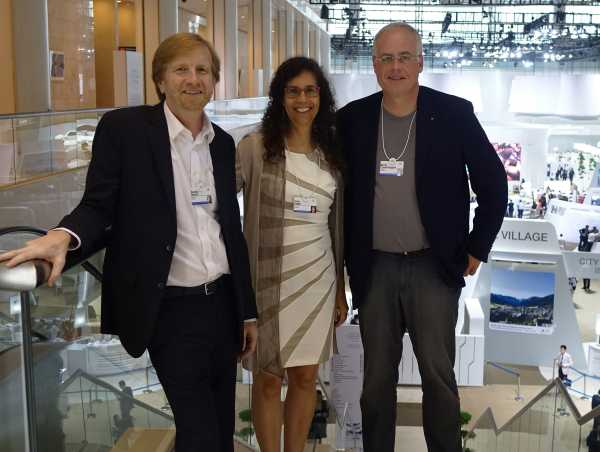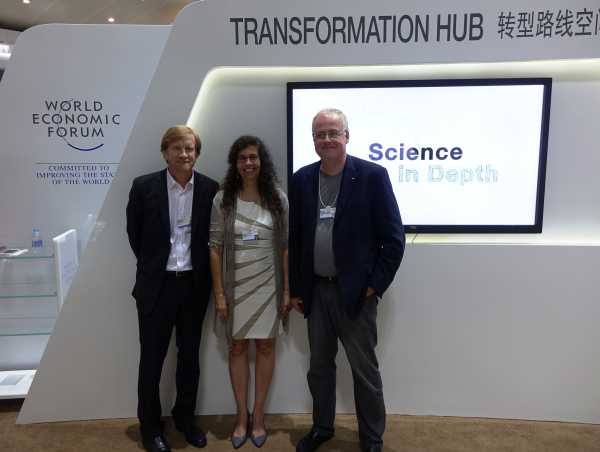Imagine healing your body with thoughts, trapping bacteria with magnets, and designing micro robots to swim like Salmonella. Speaking on the interface between biology and engineering, ETH Zurich professors step into the Ideas Lab at the World Economic Forum in Tianjin, China.
Focused on transformative research that melds technology with the physical, biological, and digital worlds, ETH Zurich professors delivered insights into technological advances in medicine yesterday at the World Economic Forum's Annual Meeting of the New Champions. During their Ideas Lab session in Tianjin, China, ETH professors Martin Fussenegger, Brad Nelson, and Viola Vogel spoke on the interface between Biology, Physics, and Engineering. As Young Scientists and Global Shapers, newly minted professor Gabriela Hug and doctoral candidate, Epameinondas (Epa) Gousopoulos were also among the 150 academic experts invited to the WEF China.
The healing power of the brain
Revealing the fascinating power of the human brain, Martin Fussenegger presented how the electrical signals of our thoughts can ultimately produce therapeutic proteins in our body. Fussenegger, a Professor of Biotechnology and Bioengineering at ETH Zurich, shared the research results of his team in Optogenetics, a science that uses light to trigger gene expression. He explained that the recorded brainwaves of subjects who adopted a specific mental state – by concentrating on a computer game or meditating on their recent vacation, for example – switched on the near-infrared LED in a wireless-powered implant remotely adjusting the level of a therapeutic protein in the bloodstream of an animal.
Fussenegger expressed anticipation that one day we may use our own "smart" watch as an electro-genetic device for the therapeutic intervention of chronic pain and epilepsy as well as Alzheimer's and Parkinson's diseases. "Eventually a patient will be able to control the level of a therapeutic protein in his bloodstream with his own mind," said Fussenegger.
Our battle with bacteria
While mind body therapy may be an appealing idea, it is more difficult for us to comprehend that every day there is a battle of epic proportion going on inside of our bodies. An estimated 35 trillion human cells fight approximately the same number of rapidly dividing bacteria. While some bacteria synthesize "good guy" molecules, pathogenic bacteria continually attempt to invade us. Viola Vogel, Deputy Head of ETH Zurich's Health Sciences and Technology Department spoke during the WEF China Ideas Lab about the physical fight of our immune cells with bacteria. Macrophages, Pac-Man-like immune cells, seek out, grab, and literally scrape bacteria off of surfaces before they can finally gobble them up. If bacteria are exposed to certain antibiotics at concentrations too low to kill them, E-coli grows out into long filaments making it difficult for macrophages to do their job.
Vogel's research team studies the hunting behaviour of macrophages and is working with researchers from ETH Zurich's Robotics and Intelligent Systems Department to test magnetic traps for bacteria. She says, "Insights into mechanical aspects at the micro and nanoscale can help us understand unanticipated side effects of commonly used drugs and lead us to discover new strategies for fighting bacterial infections."
Inspired by Salmonella
"When engineers face a problem, they look to nature for inspiration," said Brad Nelson. Nelson, a professor in the Institute of Robotics and Intelligent Systems, and his team focus on the development, manufacturing and applications of micro and nano robots. Engineering robots on micro and nano scales required that Nelson and his team look to nature in order to overcome the seeming limitations of physics. During the Ideas Lab at WEF China, he shared how the flagella – a tail-like appendage makes bacteria like E. coli and Salmonella avid swimmers. "Nature invented the rotary motor," said Nelson who was inspired to develop tiny corkscrew shaped artificial flagella propelled by a magnetic field one thousand times less strength than an MRI. Nelson anticipates that in the coming decade(s) nano robots – so small that some 30 million could be contained in a single drop of water – will deliver targeted drug and stem cell therapies to specific cells in the body. Currently, Nelson's patented research has led to a clinical approach for steering tiny catheters into the heart.

Young Scientists and Global Shapers
The WEF also brings together a community of Young Scientists and Global Shapers who are among the world's most innovative minds. Gabriela Hug, a new professor in ETH Zurich's Information Technology and Electrical Engineering Department, addressed a forum of Young Scientists in Tianjin on how we can optimize the electric power system while minimizing costs as we move towards renewable and sustainable energy (read more in the article on ETH Zurich News)
A doctoral candidate in Chemistry and Applied Biosciences at ETH Zurich, Epa Gousopoulos was involved in the Global Shapers programme during the Annual Meeting of the New Champions. Gousopoulos will defend his research on lymphedema, a debilitating post-cancer treatment complication, following the WEF. Passionate about translational medicine, he aims to clarify the biological mechanisms leading to the complications that frequently follow breast and gynaecological cancer treatments.
ETH Zurich professors present an Ideas Lab at the World Economic Forum's Annual Meeting of the New Champions in Tianjin, China
 Illustrating the interface between Biology, Physics, and Engineering at WEF China.
Illustrating the interface between Biology, Physics, and Engineering at WEF China.
 Brad Nelson, Viola Vogel, and Martin Fussenegger team up for an Ideas Lab at the WEF in Tianjin, China.
Brad Nelson, Viola Vogel, and Martin Fussenegger team up for an Ideas Lab at the WEF in Tianjin, China.

References
external pageWorld Economic Forum Annual Meeting of the New Champions 2016call_made
external pageWorld Economic Forum Young Scientistscall_made
external page"How Many Cells Are In Your Body?" National Geographic, 23.10.2013call_made
external page"All about migration in Switzerland," Global Shapers - Zurichcall_made

